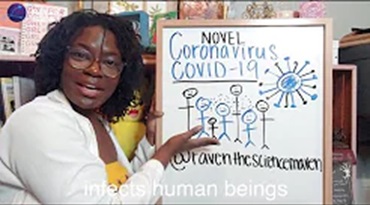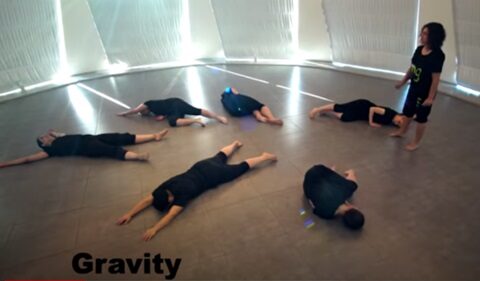Article written by Eli Typhina and Sarah Gregory
Van Jones argues that science lies in the “head” zone, a place of ideas and theories that support a culture of thought (Ibrahim, 2022). But what leads us to act on those thoughts? Art, music, dance…these “heart” zone activities lead to curiosity, inspire action, and can even cause outrage (Ibrahim, 2022). For example, statistical descriptions of the effects of climate change don’t seem to pull at one’s emotions like images of starving polar bears or people standing on their submerged homes. Scientists can tap into the heart zone to ignite action while making their research appealing and memorable. The following paragraphs give tips and inspiring stories of scientists who engage audiences through visual, musical, and performance arts, while at the same time communicating valuable information about their research.
Visual stimuli is one of the easiest ways to engage your audience’s heart space. A consistent color palette and typeface can brand your communication while stimulating interest and improving memory of scientific posters, websites, slide decks, infographics, and social media posts. For example, Food Science Babe uses a consistent color palette, font, and style on her Instagram page that includes a rainbow in her logo and a “rainbow” of tabs under her bio (Figure 1). Research that lends itself to visual imagery can benefit from pairing with artistic renditions, such as Jill Pelto’s watercolors that communicate her climate change research (Catalina, 2017) and Susan McConnell’s animal photography that embodies her animal behavior research.
Figure 1. Screen capture of Food Science Babe’s Instagram account showing consistent color palette, typeface, and design features that can increase audience recognition of and interest in her research.
Furthermore, scientists can inspire passion in the heart zone with ‘science’ music. Dall’Acqua (2022) calls music a ‘universal language’ that creates a sense of unity within a group in the way it elicits emotions and creates a shared experience of rhythms and tones. Scientist-musician collaborations include undergraduate music student Daniel Crawford and geography professor Scott St. George, who created “A Song of Our Warming World” by turning 133 years of climate change data into an auditory rendition of rising temperatures (Hansman, 2015), and Canadian rapper Baba Brinkman, who works directly with scientists to develop songs about science and society. Scientists can also create their own music as molecular biologist Dr. Raven Baxter does. For example, Baxter’s music video “Wipe It Down” encouraged hygienic practices during the COVID-19 pandemic reaching 52,706 views at the time of this publication (Figure 2).
Figure 2. Screen capture of Raven Baxter’s music video titled “Wipe It Down” conveyed scientific research in a memorable and fun way.
Performance serves as another emotionally and physically enlivening activity that can kinaesthetically merge the heart with the head zones (Notch, 2021). For example, Zafra Lerman’s (Pewsey, 2022) students altered the play Romeo and Juliet to explain the process of chemical bonding, while Tonie Stolberg (2006) worked with a dance company to create a dance-drama about the carbon cycle. Roni Zohar understood the power of movement and researched how to teach physics through dance. This led to her video Movements as a Door for Learning Physics Concepts (Amsen, 2019) (Figure 3). Watching submissions to “Dance Your Ph.D.,” a global video competition, can inspire science and movement pairings. According to contest creator John Bohannon, the videos not only change “the way [scientist creators] talk about their work but…their entire life and career” (Amsen, 2019).
Figure 3. Screen capture of Zohar’s “Embodied Pedagogy” where students demonstrate and experience the concept of gravity.
Scientists, connect your head zone materials with heart zone experiences. Examine your research to see which mediums it lends itself to, like how physics concepts pair well with dance. Then look for collaborators and supporters, such as colleagues in the humanities, artists in your community, students, and science communication groups (e.g. Association of Science Communicators). Additionally, look for platforms designed to bring scientists and artists together, such as Lifeology, STEMedia, Fiverr, and Upwork. Through discussions and creating art with others on your research, you might just find yourself in a whole new heart space.
References
Amsen, E. (15 Mar 2019). These Scientists Are Dancing Their Research. Forbes. Retrieved from: https://www.forbes.com/sites/evaamsen/2019/03/15/these-scientists-are-dancing-their-research/?sh=732995a85f9b
Catalina, E. 2017. Communicating science through art. UMaine Today. Retrieved from: https://umainetoday.umaine.edu/stories/2017/communicating-science-art/
Dall’Acqua, M. (2022). The Science Within Music. The Science Communication Club. Retrieved from: https://scc.sa.utoronto.ca/content/the-science-within-music/
Hansman, H. (21 Sept 2015). This Song Is Composed From 133 Years of Climate Change Data. Smithsonian Magazine. Retrieved from: https://www.smithsonianmag.com/science-nature/this-song-composed-from-133-years-climate-change-data-180956225/
Ibrahim, A. (27 Jun 2022). What is Art? Why is Art Important? TheArtist. Retrieved from: https://www.theartist.me/art/what-is-art/
Notch. (29 April 2021). Science on the dance floor – Is dance an effective means of science communication? Notch Communications. Retrieved from: https://notchcommunications.co.uk/science-on-the-dance-floor-is-dance-an-effective-means-of-science-communication/
Pewsey, E. (28 Jan 2022). In situ with Zafra Lerman. Chemistry World. Retrieved from: https://www.chemistryworld.com/culture/zafra-lerman-i-used-art-music-dance-drama-poetry-animation-anything/4015015.article
Stolberg, T. L. (2006). Communicating science through the language of dance: A journey of education and reflection. Leonardo, 39(5), 426-432. https://direct.mit.edu/leon/article-abstract/39/5/426/44954/Communicating-Science-through-the-Language-of?redirectedFrom=fulltext
Acknowledgements
We would like to thank the NC State University Office of Undergraduate Research for funding assistance, as well as these science communicators who inspired this article:
- Alex Dainis (Linktree)
- Michelle Jewell (Website I Twitter)
- Sarah McAnulty (Linktree)
- Sophie Milbourne (Website)


